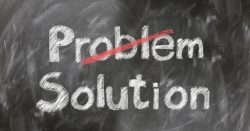Parts of Speech: Pronouns, Part 2 – Some of the Issues
 In last week’s post, we talked about the six types of pronouns. Pronouns can be pretty troublesome. This post will clear up some confusions about personal and reflexive/intensive pronouns, namely:
In last week’s post, we talked about the six types of pronouns. Pronouns can be pretty troublesome. This post will clear up some confusions about personal and reflexive/intensive pronouns, namely:
Is it I or me ? and the rest of those
It is it’s or its ?
When do I use me, when do I use I , and when do I use myself ?
Pronouns have “cases,” or different forms for different uses. Thank goodness English pronouns have only three cases; some languages have eight and have them for nouns as well; we really don’t.
The nominative case is used for subjects. Those pronouns are I, we, you, he, she, they, and it. That is why we don’t say “Him and me went to the show.” Whoever is doing the action of the verb is the subject, and it usually (but not always) appears at or near the beginning of the sentence. He and I went to the show. She and I went to the show. She and they went to the show. However, note that after the “to be” verb ( is, are, was, etc.), we use the nominative case as well. So it is correct to say, It is I or This is she , although it sounds a little stilted. So if you want to say, It’s me , I am not going to stop you.
The objective case is used for objects. Those pronouns are me, you, him, her, it, us, and them . They come after the verb and sometimes after a preposition. I saw him. I made her a cake. I did it for them. I saw him and her. He gave it to Jim and me. Note that after a preposition such as by, for, to, with, and any other preposition, you use the objective case pronouns.
The possessive case is obviously used for possession. Those pronouns are mine, yours, his, hers, ours, its, and theirs. (My, your, her, their, and your are usually used as adjectives, so I didn’t include them.) So if you ever forget whether to use its or it’s, remember that its is the possessive one. AND, like its, none of the possessive pronouns have an apostrophe (but possessive nouns do).
The reflexive pronouns have the same form as the intensives; it just depends on how they are used. They are the pronouns ending in -self or -selves: myself, ourselves, yourself, yourselves, herself, himself, itself, and themselves.
Intensive: (used for emphasis) I myself climbed that mountain. OR She climbed that mountain herself.
Reflexive: (refers back to the subject). I gave myself a manicure. She baked herself a birthday cake.
These pronouns are NOT used as subjects. These sentences are incorrect:
He and myself built our house.
Myself and my brothers took a cruise.
These pronouns, however, can be used as objects: direct, indirect, or object of a preposition:
I saw myself in the mirror. (direct object)
I gave myself a manicure. (indirect object; manicure is the direct object of gave .)
I did it by myself. (object of the preposition by )
In all the correct sentences using the -self pronouns, what do you notice? Yup. If you use myself, the subject is I. If you use herself, the subject is she. The subject matches the object pronoun. If the -self pronoun doesn’t match the subject pronoun, you likely need to use the objective case, not the reflexive:
NO: He saw my brother and myself walking down the street. YES: He saw my brother and me walking down the street.
NO: She said her cousin and myself are the only people she could trust. YES: She said her cousin and me are the only people she can trust.
Please let me know if you have any other questions about these two types of pronouns. I think I covered it all. Next week, we will talk about interrogative and relative pronouns.



